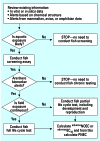Screening and testing for endocrine disruption in fish-biomarkers as "signposts," not "traffic lights," in risk assessment
- PMID: 16818255
- PMCID: PMC1874181
- DOI: 10.1289/ehp.8062
Screening and testing for endocrine disruption in fish-biomarkers as "signposts," not "traffic lights," in risk assessment
Abstract
Biomarkers are currently best used as mechanistic "signposts" rather than as "traffic lights" in the environmental risk assessment of endocrine-disrupting chemicals (EDCs). In field studies, biomarkers of exposure [e.g., vitellogenin (VTG) induction in male fish] are powerful tools for tracking single substances and mixtures of concern. Biomarkers also provide linkage between field and laboratory data, thereby playing an important role in directing the need for and design of fish chronic tests for EDCs. It is the adverse effect end points (e.g., altered development, growth, and/or reproduction) from such tests that are most valuable for calculating adverseNOEC (no observed effect concentration) or adverseEC10 (effective concentration for a 10% response) and subsequently deriving predicted no effect concentrations (PNECs). With current uncertainties, biomarkerNOEC or biomarkerEC10 data should not be used in isolation to derive PNECs. In the future, however, there may be scope to increasingly use biomarker data in environmental decision making, if plausible linkages can be made across levels of organization such that adverse outcomes might be envisaged relative to biomarker responses. For biomarkers to fulfil their potential, they should be mechanistically relevant and reproducible (as measured by interlaboratory comparisons of the same protocol). VTG is a good example of such a biomarker in that it provides an insight to the mode of action (estrogenicity) that is vital to fish reproductive health. Interlaboratory reproducibility data for VTG are also encouraging; recent comparisons (using the same immunoassay protocol) have provided coefficients of variation (CVs) of 38-55% (comparable to published CVs of 19-58% for fish survival and growth end points used in regulatory test guidelines). While concern over environmental xenoestrogens has led to the evaluation of reproductive biomarkers in fish, it must be remembered that many substances act via diverse mechanisms of action such that the environmental risk assessment for EDCs is a broad and complex issue. Also, biomarkers such as secondary sexual characteristics, gonadosomatic indices, plasma steroids, and gonadal histology have significant potential for guiding interspecies assessments of EDCs and designing fish chronic tests. To strengthen the utility of EDC biomarkers in fish, we need to establish a historical control database (also considering natural variability) to help differentiate between statistically detectable versus biologically significant responses. In conclusion, as research continues to develop a range of useful EDC biomarkers, environmental decision-making needs to move forward, and it is proposed that the "biomarkers as signposts" approach is a pragmatic way forward in the current risk assessment of EDCs.
Figures



Similar articles
-
Challenges and opportunities with the use of biomarkers to predict reproductive impairment in fishes exposed to endocrine disrupting substances.Aquat Toxicol. 2010 Oct 1;100(1):9-16. doi: 10.1016/j.aquatox.2010.07.003. Epub 2010 Aug 3. Aquat Toxicol. 2010. PMID: 20727601
-
Interpretation of fish biomarker data for identification, classification, risk assessment and testing of endocrine disrupting chemicals.Environ Int. 2016 Jul-Aug;92-93:422-41. doi: 10.1016/j.envint.2016.04.003. Epub 2016 May 5. Environ Int. 2016. PMID: 27155823 Review.
-
Vitellogenin levels and others biomarkers show evidences of endocrine disruption in fish species from Iguaçu River - Southern Brazil.Chemosphere. 2017 Nov;186:88-99. doi: 10.1016/j.chemosphere.2017.07.111. Epub 2017 Jul 24. Chemosphere. 2017. PMID: 28772185
-
Vitellogenin synthesis in primary cultures of fish liver cells as endpoint for in vitro screening of the (anti)estrogenic activity of chemical substances.Aquat Toxicol. 2006 Oct 25;80(1):1-22. doi: 10.1016/j.aquatox.2006.07.013. Epub 2006 Sep 1. Aquat Toxicol. 2006. PMID: 16950525 Review.
-
Environmental effect assessment for sexual endocrine-disrupting chemicals: Fish testing strategy.Integr Environ Assess Manag. 2010 Oct;6(4):653-62. doi: 10.1002/ieam.92. Integr Environ Assess Manag. 2010. PMID: 20872646
Cited by
-
The impact of bisphenol A on the placenta†.Biol Reprod. 2022 May 17;106(5):826-834. doi: 10.1093/biolre/ioac001. Biol Reprod. 2022. PMID: 35020819 Free PMC article.
-
Assessment of reproductive and developmental effects of graphene oxide on Japanese medaka (Oryzias latipes).Chemosphere. 2020 Nov;259:127221. doi: 10.1016/j.chemosphere.2020.127221. Epub 2020 Jun 22. Chemosphere. 2020. PMID: 32615454 Free PMC article.
-
Screening of endocrine disruption activity in sediments from the Uruguay River.Ecotoxicology. 2014 Aug;23(6):1137-42. doi: 10.1007/s10646-014-1244-4. Epub 2014 May 7. Ecotoxicology. 2014. PMID: 24802028
-
Implementing ecopharmacovigilance in practice: challenges and potential opportunities.Drug Saf. 2013 Jul;36(7):533-46. doi: 10.1007/s40264-013-0049-3. Drug Saf. 2013. PMID: 23620169 Free PMC article.
-
Biological response of high-back crucian carp (Carassius auratus) during different life stages to wastewater treatment plant effluent.Environ Sci Pollut Res Int. 2013 Dec;20(12):8612-20. doi: 10.1007/s11356-013-1817-4. Epub 2013 May 22. Environ Sci Pollut Res Int. 2013. PMID: 23695857
References
-
- Andersen L, Holbech H, Gessbo A, Norrgren L, Petersen GI. Effects of exposure to 17α-ethinylestradiol during early development on sexual differentiation and induction of vitellogenin in zebrafish (Danio rerio) Comp Biochem Physiol C Toxicol Pharmacol. 2003;134:365–374. - PubMed
-
- Ankley GT, Jensen KM, Kahl MD, Korte JJ, Makynen EA. Description and evaluation of a short-term reproduction test with the fathead minnow (Pimephales promelas) Environ Toxicol Chem. 2001;20:1276–1290. - PubMed
-
- Ankley GT, Jensen KM, Makynen EA, Kahl MD, Korte JJ, Hornung MW, et al. Effects of the androgenic growth promoter 17-β-trenbolone on fecundity and reproductive endocrinology of the fathead minnow (Pimephales promelas) Environ Toxicol Chem. 2003;22:1350–1360. - PubMed
-
- Ankley GT, Johnson RD. Small fish models for identifying and assessing the effects of endocrine-disrupting chemicals. Inter Lab Anim Res J. 2004;45:467–481. - PubMed
-
- Ankley GT, Kahl MD, Jensen KM, Hornung MW, Korte JJ, Makynen EA, et al. Evaluation of the aromatase inhibitor fadrozole in a short-term reproduction assay with the fathead minnow (Pimephales promelas) Toxicol Sci. 2002;67:121–130. - PubMed
Publication types
MeSH terms
Substances
LinkOut - more resources
Full Text Sources

